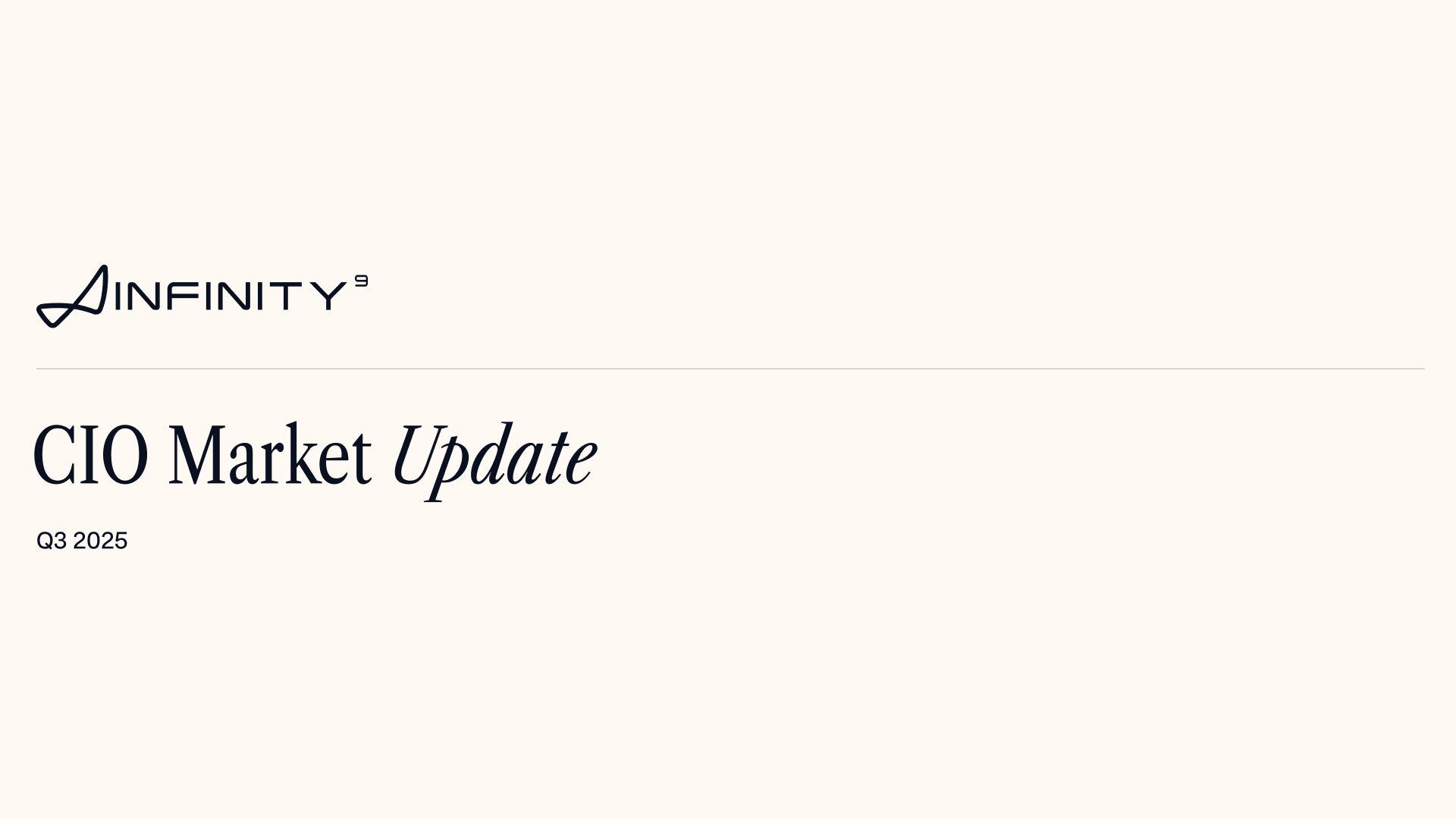Executive Summary
As Q3 2025 concludes, commercial real estate continues to stabilize within a complex macroeconomic and capital markets environment. The U.S. economy has remained resilient with steady GDP growth and strong consumer demand, even as inflation remains above target and interest rates stay elevated. Capital markets are recalibrating, with public equities reflecting optimism and credit markets still exercising caution. These crosscurrents are creating opportunities for disciplined investors. And in our view, U.S. commercial real estate remains one of the most compelling ways to access durable, risk-adjusted yield and long-term capital appreciation, even in today’s evolving environment.
Sector performance remains highly differentiated. Multifamily is absorbing record levels of demand while new starts decline, setting up a rent recovery in 2026. Industrial is resetting, with muted absorption but robust third-party logistics demand and a contracting pipeline. Retail continues to demonstrate exceptional stability, led by necessity-based formats. Office remains bifurcated, with demand focused on Class A, amenitized space in core markets. Hospitality is seeing selective recovery in luxury and urban segments, while margins remain under pressure. Credit and structured capital strategies continue to offer compelling opportunities amid constrained lending.
Macroeconomic Backdrop
The macroeconomic environment is sending mixed signals. On one hand, the U.S. economy remains on solid footing: Q2 GDP was revised upward to 3.3%, with Q3 tracking at 3.5%. Consumer spending has held strong, supported by real wage growth and a resilient labor market. On the other hand, inflation remains sticky—core PCE stands at 2.9%—and long-term interest rates have moved higher, suggesting persistent concerns about inflation and fiscal policy.
Policy-driven headwinds are adding to investor caution. Tariffs on construction materials and stricter immigration enforcement are impacting both input costs and labor availability, particularly in housing and development projects. Uncertainty around trade agreements and fiscal deficits may prolong volatility and cloud visibility into the Fed’s timeline for easing.
Despite these expectations, long-term interest rates have moved higher, suggesting ongoing concerns about inflation and fiscal spending. The federal deficit remains elevated, the national debt has surpassed new records, and money supply growth is accelerating. The U.S. dollar has also weakened materially, which could further impact inflation and cross-border capital flows.
Taken together, this backdrop presents a mixed picture: a resilient consumer and economy on one hand, and structural headwinds like high debt levels, persistent inflation, and global trade instability on the other.
Capital Markets Insight
Capital markets are showing early signs of normalization. Public equity markets have surged, buoyed by expectations of easing monetary policy and better-than-expected earnings. The S&P 500 has recorded 20+ all-time highs this year, and volatility has fallen to multi-year lows. Meanwhile, bond markets remain cautious. Credit spreads have narrowed, but long-duration debt remains under pressure as investors weigh inflation risks.
Trade policy remains a swing factor. Recent tariffs on key inputs like steel and lumber have increased project costs and delayed starts across several CRE asset classes. Equity capital is becoming more expensive, especially for development, and lenders remain selective. These dynamics continue to favor structured capital with real asset coverage, well-aligned sponsorship, and clearly defined exits.
Real estate capital flows are improving selectively. Preferred equity and structured credit continue to gain momentum as sponsors seek flexible, non-bank capital. CMBS and traditional lenders remain conservative, creating opportunity for well-positioned investors to fill capital stack gaps with downside-protected structures.
Transaction volume is recovering, particularly in institutional-quality assets where pricing discovery has settled. The bid-ask spread is narrowing, and we expect deal flow to increase into year-end.
Sector Highlights
Industrial
The industrial sector is stabilizing after a rapid expansion cycle. Leasing activity rose slightly in Q2, led by third-party logistics (3PL) tenants, but overall absorption slowed due to delayed occupancy and a rise in bankruptcies. Vacancy ticked up to 7.5%, but construction deliveries have fallen to their lowest level since 2019. While industrial demand remains intact, a potential recession could weigh on space tied to consumer-discretionary goods. Long-term fundamentals remain anchored by e-commerce, nearshoring, and automation-led tenant demand.Key investment drivers include:
- 3PL demand and e-commerce supporting leasing
- Supply pipeline at multi-year lows
- Tenant preference shifting to automation-ready space
Investor Takeaway: Modern industrial remains a compelling long-term investment, especially in logistics corridors and near-shoring markets.
Office
The office sector continues to reflect a bifurcated market environment. Prime, Class A buildings in core submarkets are outperforming, while commodity office space faces sustained headwinds. Leasing activity remains concentrated in mid-sized blocks (10k–20k sq. ft.) and driven by sectors like tech, legal, and financial services seeking flight-to-quality and amenity-rich environments. Vacancy in top-tier buildings is materially lower than in broader stock.
Development has slowed significantly. This constrained pipeline is expected to help rebalance supply-demand fundamentals in 2026 and beyond. However, tenant improvement costs and leasing incentives remain elevated, and underwriting must reflect these realities.Key investment drivers include:
- Top-tier office commanding a premium in rents and leasing velocity
- Development pipeline at historical lows
- Capital favoring recap structures and structured equity in stabilized assets
Investor Takeaway: Selectively positioned office assets, particularly those in prime locations with institutional sponsorship, remain attractive when structured with downside protection and defined business plans.
Retail
Retail fundamentals remain among the most stable across asset classes. Grocery-anchored centers and essential retail formats are continuing to deliver strong leasing activity and income durability. Vacancy rates remain below 5% in most top metros, and retailers are adjusting footprints to align with omnichannel and hybrid shopping behaviors. Suburban and secondary markets with population growth are capturing a larger share of leasing momentum. Physical retail remains highly relevant, especially for experiential categories like food & beverage, services, and health & wellness.
Key investment drivers include:
- Open-air and grocery-anchored centers leading retail resilience
- Leasing velocity is strong across discount and service-based categories
- Limited new development reduces supply-side risk
Investor Takeaway: Retail remains a reliable, cash-flow-driven asset class, especially in necessity-based formats. Long-term tenancy, inflation-linked leases, and low capex requirements support stable returns.
Hospitality
Hospitality is stabilizing across most markets but remains highly segment- and market-specific. RevPAR growth is moderating, driven by average daily rate (ADR) gains more than occupancy. Urban and luxury assets are outperforming midscale and suburban properties, benefiting from resilient domestic demand and the gradual return of international travel. However, margins are under pressure due to higher wages, insurance costs, and F&B inflation. New supply is limited, with the national development pipeline at a multi-year low. Key investment drivers include:
- Rate-driven RevPAR recovery in urban and destination markets
- Limited supply growth supports pricing power
- Margin compression requires more rigorous underwriting
Investor Takeaway: Branded assets in gateway cities and experiential destinations offer attractive upside for disciplined sponsors.
Multifamily
Multifamily continues to show a strong foundation, even amid short-term headwinds. National absorption in Q2 exceeded 116,000 units, a key signal that the sector is stabilizing after digesting a surge in supply over the last 24 months. Construction activity is also slowing, with starts at their lowest level since 2016, setting the stage for an improved rent growth environment in 2026.
Gateway and coastal markets are outperforming due to their affordability gap versus homeownership. At the same time, Sun Belt markets that were previously oversupplied are now beginning to normalize, with occupancy rates rising and concessions tapering. The rent vs. mortgage spread remains wide across nearly all major metros, driving continued renter demand.Key investment drivers include:
- Absorption at 20-year highs while construction slows.
- Rent affordability remains attractive vs. ownership in most metros.
- Markets with high job and population growth continue to lead recovery.
Investor Takeaway: Multifamily offers long-term tailwinds, with a narrowing supply pipeline and steady demand. Select markets are already showing improved rent growth and absorption, creating opportunity for well-structured investments.
Private Credit and Structured Equity
Structured equity remains the most attractive entry point in the current environment. Sponsors continue to seek short-term, non-bank financing to fund lease-ups, recapitalizations, and value-add transitions. Structures with defined exits and real asset coverage are commanding premiums, and investor demand remains strong for short-duration yield strategies.Key investment drivers include:
- Continued dislocation in bank lending markets
- Preferred equity and mezzanine filling funding gaps
- Capital rotation into downside-protected, income-focused vehicles
Investor Takeaway: Short-duration credit strategies remain a core allocation for capital seeking yield with asymmetric downside protection.
Outlook from the CIO
Looking ahead to Q4 and 2026, we see both challenges and opportunity. Inflation, interest rates, and policy risk remain active variables, but conditions are improving across several real estate sectors. Multifamily and industrial are rebalancing; retail continues to deliver stable income; and selective office and hospitality strategies are emerging.We remain focused on preferred equity and short-duration credit—structures that offer defined income, downside protection, and flexibility in a capital-constrained environment. Our framework is conservative by design, with a focus on control, clarity, and income durability.Periods of dislocation reward disciplined capital. We believe the next cycle will favor managers who combine structure and creativity, and Infinity⁹ is positioned to lead in that environment.
Disclaimer
This material has been prepared by Infinity⁹ for informational and educational purposes only. It is not intended as, and should not be construed as, investment advice, a recommendation, or an offer or solicitation to buy or sell any security, investment product, or financial instrument. Nothing herein should be interpreted as a promise or guarantee of future performance. Past performance is not a reliable indicator of future results. All investments involve risk, including the potential loss of principal. There is no assurance that any investment strategy will achieve its objectives, generate profits, or avoid losses.
This document may include forward-looking statements, projections, or forecasts that are inherently subject to risks, uncertainties, and assumptions that are difficult to predict. Actual outcomes and results may differ materially from those expressed or implied. Market conditions, interest rates, and economic factors may change, which can materially impact portfolio strategies and returns.Investments in real estate are subject to risks including, but not limited to: illiquidity, declining property values, changing economic conditions, local market risks, regulatory changes, rising interest rates, and tenant defaults. Private real estate investments are typically speculative and intended for qualified investors who understand and are willing to accept their risks, including illiquidity, lack of transparency, and valuation complexity. Private credit investments may be subject to higher risk due to limited liquidity, borrower creditworthiness, structural complexity, and lack of public disclosure. Leveraged and structured credit instruments, including mezzanine loans, preferred equity, and payment-in-kind (PIK) structures, carry additional risks related to capital impairment and default.
These investments may involve derivative instruments or leverage, which can magnify gains and losses.Investing in foreign or emerging markets may involve heightened risks related to currency fluctuations, political instability, and reduced market transparency. Strategies that invest in mortgage-backed securities, collateralized debt obligations, or other structured instruments may be particularly sensitive to interest rate movements, market volatility, and prepayment or extension risk.
Diversification does not ensure a profit or protect against losses in declining markets. Asset allocation does not eliminate risk. All data, figures, charts, and market commentary contained herein are based on information believed to be accurate and reliable as of the date of publication but are subject to change without notice.
Infinity⁹ and its affiliates make no representation or warranty as to the completeness or accuracy of the information, and accept no liability for any direct or consequential loss arising from its use.Investors should consult their legal, tax, and financial advisors before making any investment decision. Any specific securities or strategies referenced are presented for illustrative purposes only and do not constitute a recommendation or guarantee of performance.
Infinity⁹ is not a bank, nor is it a registered broker-dealer or investment advisor. All offerings, if applicable, are made pursuant to relevant securities laws and regulations, and only to qualified investors who meet the necessary suitability requirements.
Sources
Macroeconomic & Capital Markets
- Charlie Bilello, The Week in Charts, September 1, 2025
- Charlie Bilello, The State of the Markets, August 2025
- CBRE Investment Management, Macro House View Q3 2025
- Fiduciary Trust, 2025 Q3 Market Outlook: Global Tailwinds in a World of Trade Tensions and Policy Change
- Morningstar Research, Fed Funds Futures & Interest Rate Forecasts, Q3 2025
- J.P. Morgan, 2025 Commercial Real Estate Midyear Outlook
- J.P. Morgan, Commercial Real Estate and a Potential Recession, September 2025
Sector-Specific Reports
- CBRE, Q2 2025 U.S. Multifamily MarketBeat
- CBRE, Multifamily Sector Overview, Midyear 2025
- CBRE, Q2 2025 U.S. Industrial & Logistics Figures
- CBRE, Industrial & Logistics Sector Outlook, 2025
- CBRE, Global Hotels Outlook, 2025
- CBRE, Q2 2025 U.S. Net Lease Investment Report
- Newmark, 2Q 2025 U.S. Retail Market Conditions and Trends Report
- Newmark, 2Q 2025 U.S. Office Figures
- Newmark, 2Q 2025 U.S. Office Leasing House View
- Newmark, Winning Office: How Class A Is Redefined, 2025
- Newmark, 1Q 2025 State of the U.S. Capital Markets
- RealPage / Atlanta Federal Reserve, Cost of Homeownership vs. Renting, via Newmark Research, July 2025
Policy & Regulatory Context
- NMRK, How to Think About Tariffs and CRE, August 2025
- U.S. Census Bureau, Retail Trade & Consumer Spending Data, May 2025
- U.S. Federal Reserve, Core PCE Inflation Data, 2025
- National Association of Realtors, Existing Home Inventory Data, April 2025







